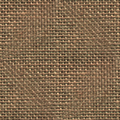Antique satin
Antique satin, also called satin-back shantung,[1] refers to any five or eight harness (shaft) satin weave that uses slubbed or unevenly spun yarns in the weft (filling).[2] It is reversible in that one side is satin and other shantung and is used for simulating 17th and 18th century silks[3] and clothing such as blouses, lingerie and evening wear.[1]
This heavy and dull fabric[4] is sensitive to damage including getting wet which leave white rings and also light which shreds it and changes the fabric color. Therefore, antique satin must not be washed and should be cleaned by a professional fabric expert.[5] The lining is also sewn into the hem so if the lining is altered, the fabric will be damaged.[6] It is usually an upholstery-weight fabric and can be made using silk, rayon or acetate[7] in the warp and coarser cotton or manmade fibers in the weft (filling). It is a satin-faced version of shantung or duppioni. The name refers to the fabric's handspun and hand woven appearance.
Antique satin was developed in the 1950s by combining acetate (warp threads) and rayon (weft threads) mainly as a decorative fabric used primarily for draperies. Unlike wedding satin with the shiny weave visible, antique satin is made of small slubs or textures on the face. The yarn most popular was known as 19/2 ply, meaning 19 threads to the inch woven as a two ply thread to create an attractive silk-like appearance. The popular, quality style is 48" wide and first appeared in limited colors. In the late 1950s a company named Penco Fabrics, owned by Jack Penzer, and based at the drapery building, 261 Fifth Avenue, NY, NY, introduced antique satin in 101 colors, virtually revolutionizing the industry. The fabric was copied by others including Fame Fabrics and Richloom, a major supplier today, and by 1963 achieved major distribution throughout the United States. Selling at the mill level for $.59 to $.79 a yard, whether in the natural off-white, undyed, fabric to black and colored warp yards with an iridescent effect at the higher price points, the fabric in its basic form remains somewhat popular today.
References
- 1 2 Young, Deborah (2015). Swatch Reference Guide to Fashion Fabrics. Bloomsbury Publishing. p. 117. ISBN 1628926562. Retrieved August 25, 2015.
- ↑ Rowe, T. (2009). Interior Textiles: Design and Developments. Elsevier. p. 69. ISBN 1845696875. Retrieved August 25, 2015.
- ↑ Yates, Marypaul (2002). Fabrics: A Guide for Interior Designers and Architects. W. W. Norton & Company. pp. 66–283. ISBN 039373062X. Retrieved August 24, 2015.
- ↑ Lewandowski, Elizabeth J. (2011). The Complete Costume Dictionary. Scarecrow Press. p. 12. ISBN 0810877856. Retrieved August 25, 2015.
- ↑ "Handling Of Antique Satin". Spartanburg Herald-Journal. November 16, 1980. Retrieved August 25, 2015.
- ↑ "A very fine vintage - how to look after your's". dailymail.co.uk. September 24, 2007. Retrieved August 25, 2015.
- ↑ Randall, Charles. The Encyclopedia of Window and Bed Coverings: Historical Perspectives, Classic Designs, Contemporary Creations. CRI Media. p. 300. ISBN 1890379336. Retrieved August 25, 2015.


.svg.png)